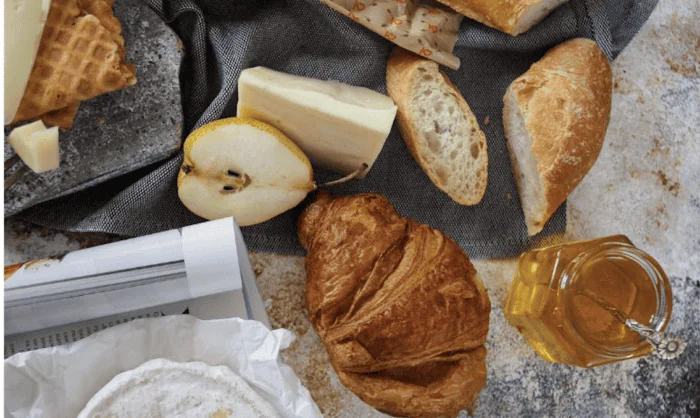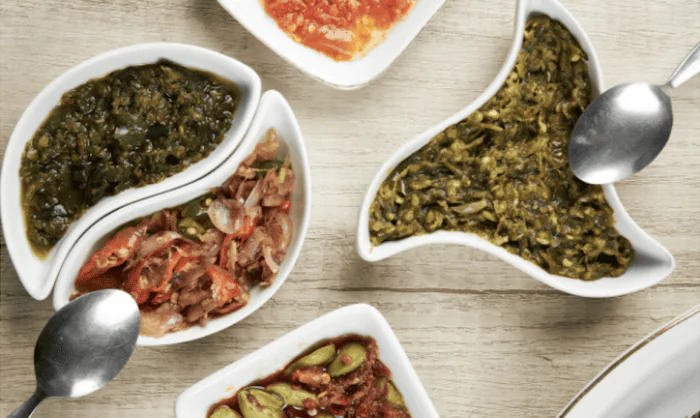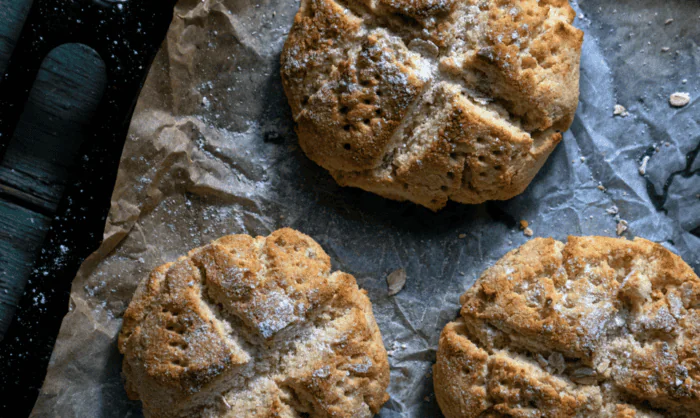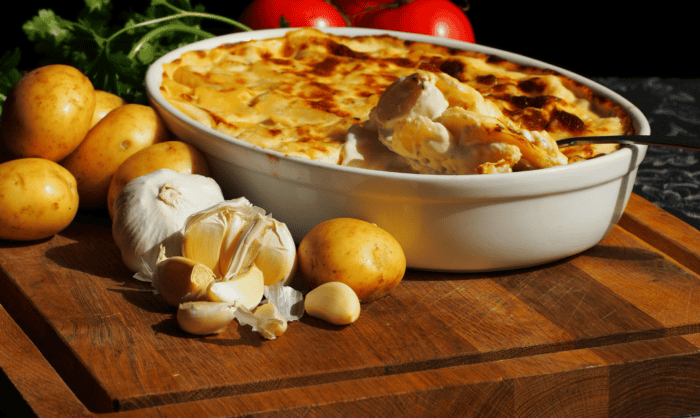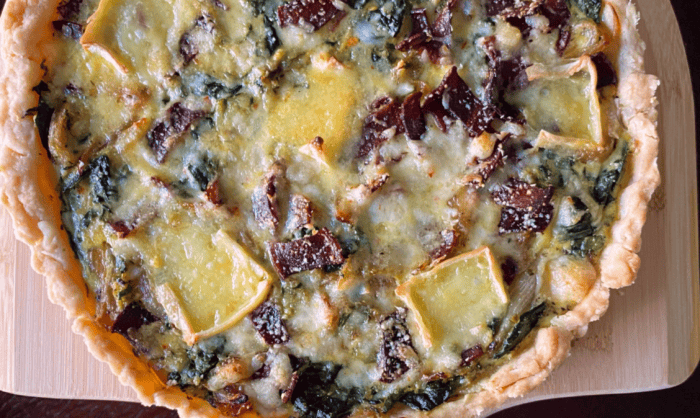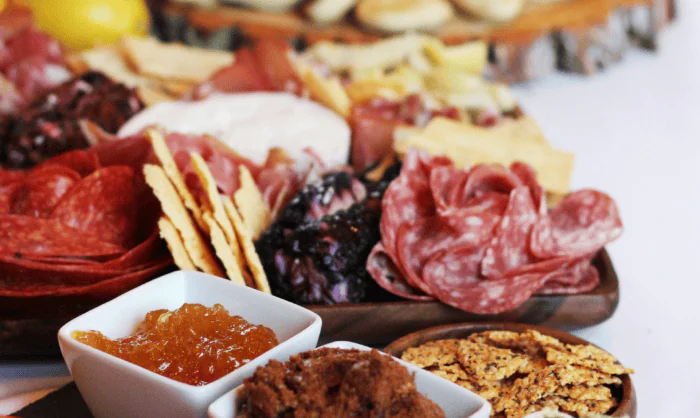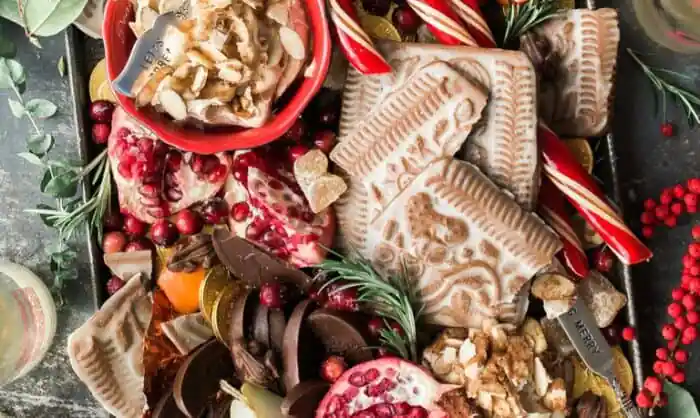Author: Casey Bumpsteed
How To Create a Christmas Sweet Treat Table
How To Create a Christmas Sweet Treat Table
Transform your celebration into a magical experience with a Christmas sweet treat table showcasing the season’s finest flavors.
This table will captivate your guests, from indulgent chocolates to sugar-free delights, offering something for every taste. Here’s your ultimate guide to crafting a dessert spread featuring Heggy’s signature confections and creative tips to elevate the presentation.

Choose the Star Treats
Your sweet table’s charm lies in the selection of irresistible treats. For a balanced mix, include:
- Chocolate buckeyes: These peanut butter and chocolate delights are a classic crowd-pleaser.
- Heggy’s haystacks: A crunchy, sweet-salty combination of pretzels coated in creamy chocolate.
- Heggy’s milk chocolate brownie creams: Luxuriously rich and perfect for brownie lovers.
- Heggy’s chocolate-covered raspberry creams: A fruity twist wrapped in decadent chocolate.
- Heggy’s milk chocolate peanut clusters: Nutty, crunchy, and satisfyingly sweet.
- Sugar-free mint meltaways: Guilt-free treats with a refreshing minty flavor.
- Sugar-free chocolate caramels: A chewy, indulgent delight minus the sugar.
- Heggy’s walnut caramels: A perfect addition for texture and flavor variety.
Plan the Presentation
A well-curated layout makes your table a visual and gastronomic delight. Here’s how to arrange it:
1. Choose a theme
Go for a festive theme, like “Winter Wonderland” with snow-white accents, or “Traditional Christmas” featuring reds, greens, and gold. Use themed tablecloths, runners, or garlands to set the tone.
2. Vary heights and layers
Use cake stands, tiered platters, and decorative bowls to create levels. This not only adds visual interest but also makes the treats more accessible.
3. Divide and conquer
Group similar items together for easy navigation. Arrange chocolates, sugar-free options, and nuts in distinct sections with labeled name cards for an elegant touch.
Add Extra Festive Flair
Add in decorative elements to tie the look together:
- Twinkling lights: String fairy lights around the table for a magical glow.
- Seasonal greenery: Add sprigs of pine, holly, or rosemary to bring natural warmth.
- Edible decorations: Use candy canes, gingerbread cookies, or chocolate ornaments to accent the table.
Sweet Pairings
Complement your treats with beverages like hot cocoa, coffee, or spiced cider. Think about creating a mini drink station beside the table for added convenience.
Accommodate Dietary Needs
Adding sugar-free options makes sure no one feels left out. Clearly label these items to guide guests with dietary preferences or restrictions.
Encourage Takeaways
Provide festive goodie bags so guests can take a piece of the magic home. Add personalized tags so that everyone feels special.
Final Touches
Before the party, make sure everything is neatly arranged and fresh. Refill empty spaces as guests enjoy the treats to keep the table looking inviting.
With a touch of creativity and the delicious charm of our confections, your Christmas sweet treat table will become the highlight of the holiday celebration. Let this joyful spread bring smiles, sweet memories, and festive cheer to your home!
The Ultimate Christmas Wreath With Cheese
Looking for a show-stopping appetizer that’s as pretty to look at as it is to eat? This Christmas wreath with cheese is the perfect centerpiece for your holiday gathering.
Made with a medley of cheeses, fresh herbs, and seasonal garnishes, it’s easy to assemble and irresistibly delicious.

If you loved this recipe, check out our Christmas breakfast ideas, plus this recipe for white cheddar and apple scones.
Recipe
Here’s what to round up to make this festive Christmas wreath with cheese, plus the exact steps to making it:
Ingredients
- 8 oz cream cheese, softened
- 4 oz goat cheese
- 1 cup shredded sharp cheddar cheese
- 2 tbsp fresh chives, chopped
- 1 tsp garlic powder
- 1/2 tsp smoked paprika
- Fresh herbs for garnish (rosemary, thyme, parsley)
- Cherry tomatoes or red grapes (for “berries”)
- Crackers, breadsticks, or veggie sticks for serving
Optional toppings:
- Toasted nuts (like pecans or almonds)
- Dried cranberries
- Pomegranate seeds
Instructions
1. Mix the cheese base: In a mixing bowl, combine the cream cheese, goat cheese, shredded cheddar, chives, garlic powder, and smoked paprika. Use a hand mixer or spatula to blend until smooth and well combined.
2. Shape the wreath: Place a sheet of parchment paper on your serving platter. Spoon the cheese mixture onto the center and form it into a circular wreath shape, leaving a hollow center. Smooth the edges using a spatula or damp hands.
3. Chill the wreath: Refrigerate the cheese wreath for at least 1 hour to firm up. This makes it easier to decorate and serve.
4. Decorate with herbs and garnishes: Remove the wreath from the fridge and carefully transfer it to your serving platter (if it isn’t already there). Arrange sprigs of fresh rosemary, thyme, or parsley around the edges of the cheese ring to mimic evergreen branches.
5. Add holiday “berries”: Use cherry tomatoes or red grapes as your “berries,” tucking them in among the herbs. For extra sparkle, add pomegranate seeds or sugared cranberries.
6. Finish with optional toppings: Sprinkle toasted nuts or dried cranberries over the top for added texture. You can even drizzle a little honey for a sweet-savory touch.
7. Serve and enjoy: Surround your cheese wreath with an assortment of crackers, breadsticks, or veggie sticks for dipping and spreading. Encourage guests to scoop up a little of everything for a burst of flavor in every bite.
Tips for Success
Here are our tips for getting the best results:
- Make ahead: Prepare the cheese wreath up to two days in advance and decorate just before serving.
- Customize the flavors: Swap out cheddar for Gouda or add crumbled blue cheese for an extra punch.
- Keep it fresh: Garnish with herbs right before serving to keep them vibrant.
This Christmas wreath with is more than an appetizer—it’s a conversation starter. Whether you’re hosting a cozy family gathering or an elegant holiday soirée, it’s guaranteed to bring smiles and festive cheer to your table.
Serving Idea:
Pair the wreath with a glass of sparkling wine or your favorite holiday mocktail for an elevated experience. Cheers to the holidays and happy entertaining!
Christmas Breakfast Ideas With Cheese
Christmas Breakfast Ideas With Cheese
Make a festive spread to remember with our Christmas breakfast ideas with cheese. From sweet to savory, this list will have you covered!
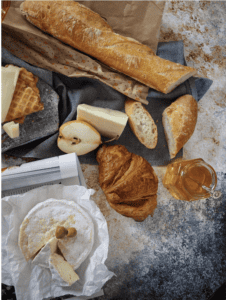
Savory Options
- Cheesy egg and sausage casserole
A hearty baked dish layered with eggs, breakfast sausage, and loads of shredded cheddar or Gruyère. - Cheese-stuffed croissants
Flaky croissants filled with brie, cream cheese, or Gruyère, baked until golden. - Spinach and cheese breakfast strata
A layered bread casserole with spinach, eggs, and a mix of Parmesan and mozzarella. - Cheddar and chive scones
Fluffy scones packed with sharp cheddar and a touch of fresh chives. - Caprese breakfast sandwich
Fresh mozzarella, tomato slices, basil, and a drizzle of balsamic glaze on a toasted English muffin. - Ham and cheese puff pastry pockets
Puff pastry filled with diced ham, cream cheese, and Swiss or Gruyère. - Cheesy potato hash
Crispy potatoes tossed with melty cheddar or Pepper Jack and topped with poached eggs. - Baked brie and cranberry pastry cups
Mini puff pastry cups filled with brie, cranberry sauce, and a sprinkle of pecans. - Cheese and herb frittata
A simple yet elegant egg dish with goat cheese, feta, or ricotta and fresh herbs. Mix in a little pumpkin butter into the egg filling. - Everything bagel breakfast pizza
Bagel halves topped with cream cheese, scrambled eggs, cheddar, and bacon crumbles.
Sweet Cheese-Inspired Options
- Ricotta pancakes with honey
Light and fluffy ricotta pancakes drizzled with honey and topped with fresh berries. - Cheesecake-stuffed French toast
Thick slices of bread filled with sweetened cream cheese and dusted with powdered sugar. - Cheese Danish pastries
Classic puff pastry filled with sweetened cream cheese and topped with fruit or jam. - Apple and brie Puff pastry braid
A stunning breakfast centerpiece filled with brie, thinly sliced apples, and a touch of cinnamon sugar. - Savory- sweet cheese board
A breakfast twist on a charcuterie board featuring soft cheeses, fruits, nuts, bagels, and spreads.
Our Top Tips for a Festive Spread
We’ve broken these up into menu and general tips:
Tips for a Great Christmas Breakfast Menu
- Plan a balanced menu: Include a mix of sweet and savory items. For example, pair pancakes or pastries with egg-based dishes or casseroles. Add a variety of textures: crispy (bacon, croissants), creamy (yogurt, cheeses), and fluffy (waffles, frittatas).
- Incorporate holiday colors: Use red and green ingredients like cranberries, pomegranates, strawberries, spinach, and basil to create a festive look. Garnish dishes with edible holiday touches such as rosemary sprigs or powdered sugar “snow.”
- Have that one showstopper dish: Make one centerpiece dish, like a baked brie wreath or a Christmas tree-shaped pull-apart bread, to wow your guests.
- Prepare ahead: Choose recipes that can be made or prepped the night before, like breakfast casseroles, overnight oats, or muffin batter. Lay out serving dishes, utensils, and decorations the evening prior.
- Incorporate cheese: We are biased, but….everyone loves cheese! Right? Check out our full range here.
- Serve seasonal drinks: Prepare a festive beverage menu featuring items like cranberry mimosas, eggnog, or spiced apple cider.
- Keep portions small: Offer bite-sized portions for variety and ease, such as mini quiches, slider-style breakfast sandwiches, or muffin tin casseroles.
- Use decorative serve ware: Go for holiday-themed plates, napkins, and serving trays to tie the theme together.
- Have DIY options: Set up stations:
- Bagel bar: Include cream cheese, smoked salmon, sliced veggies, and festive toppings.
- Pancake or waffle station: Offer syrups, fresh fruit, whipped cream, and sprinkles.
- Hot chocolate bar: Provide cocoa, marshmallows, whipped cream, peppermint sticks, and chocolate shavings.
General Tips for a Great Christmas Breakfast
- Make it interactive: Include a group activity to enhance the experience, like decorating Christmas cookies or building a gingerbread house after breakfast.
- Label dishes: Add small cards to identify each dish, mainly if you include allergy-friendly or gluten-free options.
- Add personal touches: Include handwritten thank-you notes or mini Christmas crackers at each place setting to make guests feel special.
- Don’t forget the kids: Offer kid-friendly options like fruit skewers, yogurt parfaits, or Christmas-shaped pancakes with fun toppings.
The Best Sides With Boneless Smoked Ham
The Best Sides With Boneless Smoked Ham
Make a classic festive meal with our list of the best sides with boneless smoked ham. Nothing screams holiday time louder than juicy, tender ham. Well, maybe turkey does, but they’re both pretty festive.
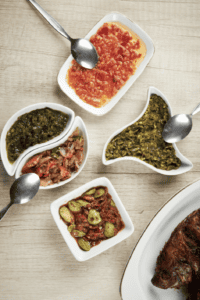
9 Ideas for Sides with Boneless Smoked Ham
Here’s a list of what we think goes really well with our boneless smoked ham:
- Garlic mashed potatoes: Boil potatoes with garlic until tender, then mash with butter and milk for a creamy texture—season with salt and pepper.
- Roasted Brussels sprouts with balsamic glaze: Toss Brussels sprouts in olive oil, salt, and pepper, then roast until crispy. Drizzle with a homemade balsamic glaze made by reducing balsamic vinegar and honey.
- Honey-glazed carrots: Steam or boil carrots until tender, then toss in a simple glaze made with melted butter and honey. Season to taste.
- Crispy roasted sweet potatoes: Cube sweet potatoes, toss them with olive oil, paprika, salt, and pepper, and roast at a high temperature until crispy and tender.
- Green bean almondine: Steam or blanch green beans, then sauté them in butter with sliced almonds and a splash of lemon juice.
- Cranberry sauce: Simmer fresh cranberries with sugar, orange juice, and zest until the berries burst and the sauce thickens.
- Buttered corn on the cob: Boil corn until tender and drizzle with melted butter, seasoning with salt and pepper.
- Cheese and herb stuffing: Combine cubed bread, shredded cheese, sautéed onions, sage, and chicken broth, then bake until golden and crispy.
- Garlic bread: Spread a mixture of softened butter, garlic, and parsley on French bread, then bake until golden and fragrant.
How To Reheat Boneless Smoked Ham for Christmas
White Cheddar and Apple Scones
White Cheddar and Apple Scones
These savory-sweet white cheddar and apple scones combine sharp white cheddar with tart apple for a perfect addition to your holiday menu.
Make them as a Christmas morning treat or side for your festive spread.
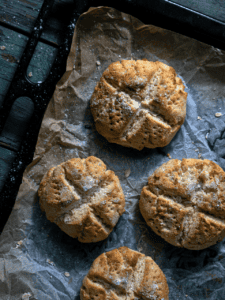
Hunting for more cheesy-based recipes? Try our Smoked Horseradish Cheese Gratin, this blue cheese tart, or our artichoke and goat’s cheese dip.
White Cheddar and Apple Scones Recipe
These apple and cheddar scones are easier to whip up than you’d think. Here’s how:
Ingredients
- 2 cups all-purpose flour
- 1 tbsp baking powder
- 1 tbsp granulated sugar
- ½ tsp salt
- ½ tsp ground cinnamon
- 6 tbsp cold unsalted butter, cubed
- 1 cup sharp white cheddar cheese, shredded
- 1 medium tart apple ( Granny Smith), peeled, cored, and finely diced
- ¾ cup heavy cream (plus extra for brushing)
- 1 large egg
Instructions
- Preheat and prep: Preheat the oven to 400°F (200°C). Line a baking sheet with parchment paper.
- Mix dry ingredients: In a large bowl, whisk together the flour, baking powder, sugar, salt, and cinnamon.
- Cut in butter: Add the cold butter cubes to the dry ingredients. Use a pastry cutter or your fingertips to work the butter into the flour until the mixture resembles coarse crumbs.
- Add cheese and apple: Stir in the shredded white cheddar and diced apple, making sure they are evenly distributed.
- Combine wet ingredients: In a small bowl, whisk together the heavy cream and egg. Pour the wet mixture into the dry ingredients, stirring gently until a shaggy dough forms.
- Shape the dough: Turn the dough out onto a lightly floured surface and gently knead it a few times to bring it together. Pat the dough into a 1-inch-thick round and cut into 8 wedges, or use a round cutter to shape individual scones.
- Prepare for baking: Place the scones on the prepared baking sheet, spacing them slightly apart. Brush the tops with heavy cream for a golden finish.
- Bake: Bake for 18–22 minutes, or until the scones are golden and firm to the touch.
- Cool and serve: Let the scones cool slightly on a wire rack before serving. Enjoy warm or at room temperature.
4 Tips for Perfect White Cheddar and Apple Scones
- Use cold ingredients: Keep the butter, cheese, and cream cold to get flaky layers.
- Don’t overmix: Stir the dough until just combined to avoid tough scones.
- Dice apples small: Finely dice the apple to evenly distribute the flavor and prevent large chunks from breaking the dough.
- Make ahead: Shape the scones, then freeze them unbaked. Bake directly from frozen, adding 2–3 minutes to the baking time.
Storage Notes
Store scones in an airtight container at room temperature for up to 2 days. For longer freshness, refrigerate for up to 5 days.
Freeze baked scones for up to 2 months. Thaw at room temperature and warm in the oven before serving.
Smoked Horseradish Cheese Gratin (The Perfect Potato Side)
Smoked Horseradish Cheese Gratin
Smoked horseradish cheese gratin is delicious with roasted meats like turkey or ham. It pairs beautifully with a crisp green salad to balance the rich flavors.
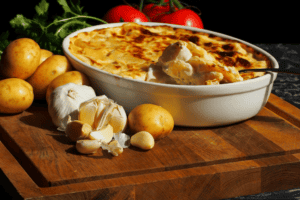
Make a batch of indulgent potato gratin layered with creamy smoked horseradish cheese as a show-stopping side dish perfect for your Christmas feast.
Smoked Horseradish Cheese Gratin Recipe
Round-up your ingredients and get cooking!
Ingredients
- 2 lbs (about 5 medium) Yukon Gold potatoes, thinly sliced
- 1 ½ cups smoked horseradish cheese, grated
- 1 ½ cups heavy cream
- 2 garlic cloves, minced
- 1 tsp fresh thyme leaves (or ½ tsp dried thyme)
- ½ tsp salt
- ½ tsp black pepper
- 2 tbsp unsalted butter, softened (for greasing the dish)
- ¼ cup breadcrumbs (optional, for topping)
Instructions
- Preheat the oven: Preheat your oven to 375°F (190°C). Grease a 9×13-inch baking dish with the softened butter.
- Prepare the potatoes: Wash and peel them, then slice them thinly (about ⅛ inch thick) using a mandoline or a sharp knife.
- Make the cream mixture: Warm the heavy cream over low heat in a small saucepan. Stir in the minced garlic, thyme, salt, and pepper. Heat until just warm but not boiling.
- Assemble the gratin:
- Layer one-third of the potato slices evenly in the prepared baking dish.
- Sprinkle one-third of the smoked horseradish cheese over the potatoes.
- Pour one-third of the warm cream mixture over the layer.
- Repeat with two more layers, finishing with the cheese and cream on top.
- Optional topping: If you like, sprinkle breadcrumbs over the top for a crispy finish.
- Bake: Cover the dish with foil and bake in the preheated oven for 40 minutes. Remove the foil and bake for an additional 20–25 minutes, or until the top is golden brown and the potatoes are tender when pierced with a knife.
- Serve: Let the gratin cool for 10 minutes before serving. Garnish with extra thyme.
This dish pairs beautifully with roast meats or as a centerpiece on a vegetarian holiday table.
10 Tips for Perfect Smoked Horseradish Cheese Gratin
Here are our top 10 tips for getting the best out of this recipe:
- Choose the right potatoes: Yukon Gold potatoes are ideal for gratins thanks to their creamy texture and ability to hold their shape. If unavailable, Russet potatoes are a good substitute.
- Slice uniformly: Use a mandoline slicer for evenly thin potato slices. This makes sure they cook evenly.
- Don’t skip the butter: Greasing your baking dish with butter prevents sticking and adds a rich, golden finish to the edges.
- Warm the cream: Heating the cream mixture before pouring it over the potatoes helps the flavors meld and reduces the overall baking time.
- Layer cheese generously: Distribute the smoked horseradish cheese evenly in each layer for a consistent, smoky flavor in every bite.
- Cover and uncover strategically: Cover with foil during the initial bake to trap steam and soften the potatoes. Remove the foil for the last 20–25 minutes to achieve a golden, bubbling crust.
- Check for doneness: Pierce the center of the gratin with a sharp knife. If it slides through effortlessly, the potatoes are fully cooked.
- Let it rest: Leave the gratin to cool for 10 minutes after baking. This helps the layers set, making it easier to serve.
- Boost flavor: Add a pinch of nutmeg or smoked paprika to the cream mixture for an extra layer of flavor.
- Crispy top hack: For an ultra-crispy topping, broil the gratin for 2–3 minutes after baking. Watch carefully to avoid burning.
Storage Notes
Store leftovers in an airtight container in the fridge for up to 3 days. Warm in a 350°F (175°C) oven until heated through, or microwave individual portions.
For longer storage, freeze fully cooled gratin in a freezer-safe dish for up to 2 months. Thaw overnight in the fridge before reheating.
Blue Cheese Tart (The Perfect Vegetarian Christmas Main)
Blue Cheese Tart (With Swiss Cheese) – A Vegetarian Main for Christmas
This homemade blue cheese tart is topped with a layer of Swiss cheese and wrapped in golden puff pastry. This elegant tart is hearty enough to be the star of the meal and pairs beautifully with festive sides.
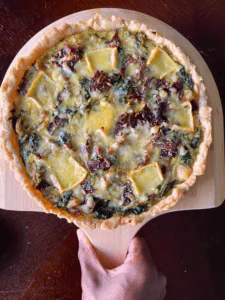
This recipe makes the perfect vegetarian main course or a side to pair with roast turkey, ham, and so on. The creamy blue cheese combines caramelized onions and a flaky crust—the thin slices of Swiss cheese layer on top to create a golden, bubbly finish.
Ingredients
Here’s what you’ll need to round up:
The pastry
- 1 sheet of puff pastry (store-bought or homemade)
- 1 tbsp flour (for rolling)
The filling
- 2 tbsp olive oil
- 2 medium onions, thinly sliced
- 2 cloves garlic, minced
- 1 cup heavy cream
- 3 large eggs
- 3 oz (85 g) blue cheese, crumbled
- 1 tsp fresh thyme leaves
- 1/2 tsp salt
- 1/4 tsp black pepper
The topping
- 4–5 slices of Swiss cheese
- Fresh thyme sprigs (for garnish, optional)
Instructions
Follow this step-by-step guide to make your own easy, absolutely delicious blue cheese tart.
Prepare the pastry
- Preheat your oven to 375°F (190°C).
- Roll out the puff pastry on a lightly floured surface and fit it into a 9-inch tart pan with a removable bottom. Trim the edges and prick the base with a fork to prevent puffing.
- Blind bake the pastry by lining it with parchment paper and filling it with pie weights or dried beans. Bake for 10 minutes, then remove the weights and bake for another 5 minutes until lightly golden.
Caramelize the onions
- Heat olive oil in a skillet over medium heat. Add sliced onions and cook, stirring occasionally, until golden and caramelized, about 15–20 minutes. Add garlic and cook for another minute. Set aside to cool slightly.
Make the filling
- Whisk together the heavy cream, eggs, blue cheese, thyme, salt, and pepper in a mixing bowl. Stir in the caramelized onions.
Assemble the tart
- Pour the filling into the pre-baked tart shell, spreading it evenly.
- Lay the Swiss cheese slices over the top, slightly overlapping to cover the surface.
Bake
- Place the tart in the oven and bake for 25–30 minutes, or until the filling is set and the Swiss cheese is golden and bubbling.
Serve
- Let the tart cool for 5–10 minutes before slicing. Garnish with fresh thyme sprigs for a festive touch, and serve warm.
Top Tips
- Choose quality cheese: Use a creamy, blue cheese like our Glacier Wildfire Gorgonzola for a balanced flavor. Go for Swiss cheese that melts beautifully, such as Gruyère or Emmental.
- Customize add-ins: Add sautéed mushrooms or roasted red peppers for extra flavor and texture.
- Prevent a soggy bottom: Ensure your tart crust is fully blind-baked before adding the filling to avoid a soggy base.
How to Store Leftovers
Cover the tart tightly with plastic wrap or place it in an airtight container. Store in the refrigerator for up to 3 days.
Slice the tart and wrap individual pieces in foil, then freeze for up to 1 month. Thaw overnight in the fridge before reheating. Warm slices in the oven at 300°F (150°C) until heated. For a crispy crust, reheat directly on a baking sheet.
Wrapping It Up
Don’t forget to check out our full range of cheese and accompaniments. We have so much to choose from and use as gifts and ingredients.
Artichoke Dip With Goat Cheese And Spinach
This artichoke dip with goat cheese is a creamy, savory dip made with goat cheese, spinach, artichokes, and Parmesan. It is an easy and perfect festive appetizer for a cozy gathering. Serve it warm with crackers, bread, or fresh vegetables for dipping.
If you loved this recipe, check out our post about Cheese Pairing with Festive Desserts: Unexpected Combos that Work.
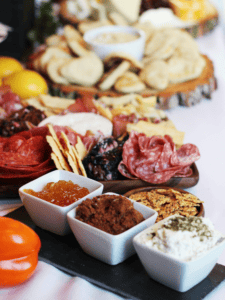
Artichoke Dip with Goat Cheese and Spinach
This simple artichoke dip can be paired with other dips and served to kick off the evening. The goat cheese balances the rich, creamy artichokes.
Ingredients
- 8 oz goat cheese (chèvre), softened
- 1/2 cup grated Parmesan cheese
- 1/2 cup sour cream or Greek yogurt
- 1/4 cup cream cheese, softened
- 1 cup frozen spinach, thawed and drained (or 1 cup fresh spinach, chopped)
- 1 cup marinated artichoke hearts, chopped
- 1/4 cup mayonnaise
- 2 cloves garlic, minced
- 1 tbsp lemon juice
- Salt and pepper, to taste
- 1/4 tsp red pepper flakes (optional)
- 1/2 cup shredded mozzarella cheese (for topping)
Instructions
- Preheat oven: Preheat your oven to 375°F (190°C).
- Prepare the spinach: If using frozen spinach, thaw and squeeze out any excess moisture. If using fresh spinach, sauté it in a pan over medium heat for 2-3 minutes until wilted, then drain.
- Mix the base: In a large mixing bowl, combine the goat cheese, cream cheese, sour cream (or Greek yogurt), mayonnaise, and lemon juice. Stir until smooth and creamy.
- Add the flavorings: Add the grated Parmesan, garlic, chopped spinach, chopped artichokes, red pepper flakes (if using), and season with salt and pepper. Stir well until everything is evenly incorporated.
- Transfer to a baking dish: Spoon the mixture into a greased 9×9-inch (or similar-sized) baking dish, spreading it evenly.
- Top with mozzarella: Sprinkle the shredded mozzarella cheese over the top of the dip.
- Bake: Bake in the oven for 20-25 minutes or until the top is golden and bubbly.
- Serve: Let the dip cool slightly before serving. Serve warm with crackers, sliced baguette, or fresh vegetable sticks (like celery, carrots, or cucumber).
Top Tips
- Spinach: Be sure to squeeze out all excess liquid from thawed frozen spinach to prevent the dip from being too watery.
- Artichokes: Marinated artichokes provide extra flavor, but you can use canned artichokes if you prefer a milder taste.
- Add-ins: Feel free to experiment with other add-ins like sautéed mushrooms, roasted red peppers, or a handful of fresh herbs (such as thyme or basil) to change the flavor profile.
- Goat cheese consistency: For a smoother dip, ensure the goat cheese is softened before mixing. If you prefer a chunkier texture, use crumbled goat cheese instead.
How to Store it
- Refrigeration: Store leftover dip in an airtight container in the fridge for 3-4 days.
- Reheating: Reheat gently in the oven at 350°F (175°C) for 10-15 minutes, or microwave in 30-second intervals until heated.
- Freezing: This dip can be frozen for up to 2 months. Let the dip cool completely to freeze, then transfer it to an airtight container or freezer-safe dish. When ready to serve, thaw overnight in the fridge and reheat in the oven.
Wrapping It Up
This creamy dip is guaranteed to be a crowd-pleaser with its rich flavors and smooth texture, making it an excellent choice for your next holiday party or gathering! Reach out to us with any questions via our contact page.
Cheese Pairing with Festive Desserts: Unexpected Combos that Work
Cheese Pairing Ideas For Festive Desserts: Unexpected Combos that Work
Cheese pairing isn’t just about cheese and crackers as part of your snacks—it can bring an exciting twist to your dessert table, too! Pairing cheese with festive sweets creates unique flavor experiences that enhance both sweet and savory elements.

Explore unexpected cheese pairing combinations like sharp cheddar with apple pie or creamy blue cheese with dark chocolate. Plus, try out a cheerful dessert board.
In this article we share cheese pairing ideas with gingerbread cookies, whipped apple butter, goat cheese (Chevin), candy canes, and seasonal fruits for an easy-to-assemble, crowd-pleasing spread.
A Festive Dessert Cheese Board with Gingerbread, Whipped Apple Butter, Goat Cheese & More
For a truly festive dessert board, bring together traditional holiday flavors with a fun mix of treats. Start with gingerbread cookies for a spiced and sweet base that pairs well with creamy cheeses.
Next, add a small bowl of whipped apple butter for a sweet, smooth spread. This is especially delicious when combined with goat cheese (Chevre). Goat’s cheese has a mild tanginess contrasts beautifully with the sweet apple butter and spicy gingerbread.
Round out the board with some seasonal flair by adding mini candy canes and fresh holiday fruits like pomegranate arils, clementines, and red grapes. These fruits add a burst of color and juicy sweetness that complements the other items on the board.
With these exciting cheese and dessert pairings, your holiday dessert spread will be as unique as it is delicious.
Cheddar and Apple Pie
The pairing of Canadian aged cheddar cheese with apple pie is a classic that has stood the test of time.
The sharp, salty taste of cheddar complements the sweetness and warmth of spiced apple filling. This combination creates a perfect balance of flavors.
For this pairing, go for a sharp or aged cheddar. It offers a strong, complex flavor that won’t get lost against the apple pie’s sweetness.
Serve small wedges of cheddar alongside individual slices of apple pie or mini hand pies for easy enjoyment.
You could also get creative by baking shredded cheddar directly onto the crust for an elevated version of this beloved pairing. Another fun idea is to serve apple and cheddar skewers—alternate cubes of cheddar with apple slices for a tasty, bite-sized treat.
Blue Cheese and Dark Chocolate
Blue cheese and dark chocolate might seem like an unexpected match, but their rich flavors complement each other beautifully. The earthy, slightly tangy flavor of blue cheese plays well with the bold bitterness of dark chocolate.
On your dessert board, break the dark chocolate into small pieces and place them next to a wedge of blue cheese. Or, create small bites by spreading a little blue cheese on top of dark chocolate squares.
You could also get creative by making dark chocolate truffles with a hint of blue cheese in the center—an adventurous twist for your holiday spread!
Beer Cheese and Fig Jam
Beer cheese and fig jam is a gentle, crowd-pleasing pairing that brings joy to any dessert table. The mild, buttery flavor of beer cheese pairs beautifully with the sweetness of our housebrand fig jam, which adds a hint of earthy complexity.
For this pairing, simply place a dollop of fig jam on each slice of beer cheese, or serve the cheese and fig jam side by side for easy spreading.
This combination works beautifully with fresh figs, sliced pears, or crackers.
Wrapping It Up
We have the most incredible cheese selective available for you to browse. Don’t miss our meats and accompaniments too!
Thanksgiving Cheese Ideas For Kids
Thanksgiving Cheese Ideas for Kids
If you’re hunting for Thanksgiving cheese ideas for kids, we’ve got you! When setting up the Thanksgiving table, cheese is an easy and popular snack choice. Typically, kids love cheese just as much as adults, so don’t leave them out!
This year, try out one or two of these fun and easy Thanksgiving cheese ideas for kids. Choose snacks that are festive, tasty, and perfect for little hands.

Cheese Turkeys
Cheese turkeys are a playful way to bring a touch of Thanksgiving spirit to snack time. To make these adorable treats, all you need are cheese rounds, veggie slices, and pretzel sticks.
Here’s how to create your own cheesy turkeys:
- Prepare the cheese rounds: choose something like Brick cheese that you can slice and can into rounds. This works well for this project. Place one cheese round per turkey on a platter.
- Add pretzel “feathers”: insert small pretzel sticks into the top half of the cheese round to create feather-like fanning behind the turkey’s head.
- Decorate with veggies: use a small slice of carrot for the turkey’s beak and black olives or edible markers for eyes.
- Add “wattles”: a small piece of red pepper or dried cranberry works perfectly to give your turkey that Thanksgiving charm.
Kids can even help assemble their own cheese turkeys, adding a personal touch to the display. Arrange the turkeys on a tray with additional veggie sticks and crackers to create a Thanksgiving-themed snack platter that’s both fun and delicious.
Mini Cheese Logs
Cheese sticks are a holiday classic, but turning them into mini versions on a stick makes them extra fun and easy for kids to enjoy.
These bite-sized treats are perfect for little hands, and the different coatings give each one a unique flavor and look. Here’s how to make your own platter of mini cheese balls on a stick.
Ingredients
- 8 oz. cream cheese or goat’s cheese, softened
- 1 cup shredded white cheddar cheese
- 1 tsp garlic powder
- 1 tsp onion powder
- Salt and pepper to taste
- Toppings for rolling (chopped nuts, dried cherries, fresh herbs like parsley or chives)
- Mini skewers
Instructions
- Make the cheese mixture: In a bowl, combine the cream or goat’s cheese, shredded cheddar, garlic powder, onion powder, salt, and pepper. Mix well until everything is evenly combined and smooth.
- Form the cheese logs: Use a spoon to scoop small portions of the cheese mixture, then roll each into a oblong log shape with your hands.
- Roll in toppings: Set out small bowls of your toppings (chopped nuts, dried cranberries, herbs) and roll each cheese ball in your choice of coating. For a festive look, create a variety platter by using different toppings for different balls.
- Assemble with sticks: Insert a toothpick or mini skewer into each cheese log to make it easy for kids to grab.
Arrange the mini cheese logs on a platter, alternating between the different coatings to create a colorful display. These little snacks are perfect for a Thanksgiving party or a family gathering, giving kids the chance to try new flavors while enjoying a familiar treat.
Cheese and Fruit Kabobs
If your kids like fruit, adding it to cheese on a kabob is a surefire way to make it even more appealing. Use cubes of mild cheese, like cheddar or mozzarella, and pair them with kid-friendly fruits like grapes, strawberries, or pineapple.
Simply thread the cheese and fruit onto small skewers or toothpicks, alternating between the two for a fun and nutritious snack. This snack is quick to assemble and can be tailored to include your kids’ favorite fruits.
These kid-friendly cheese snacks bring holiday joy to the table with minimal fuss and lots of fun. They’re easy to make, visually festive, and, best of all, they help make holiday gatherings more inclusive and enjoyable for everyone—even the smallest guests!
Wrapping It Up
We hope this post brought you some family fun inspiration! Don’t forget to check out our selection of cheeses here, plus our selection of accompaniments.



